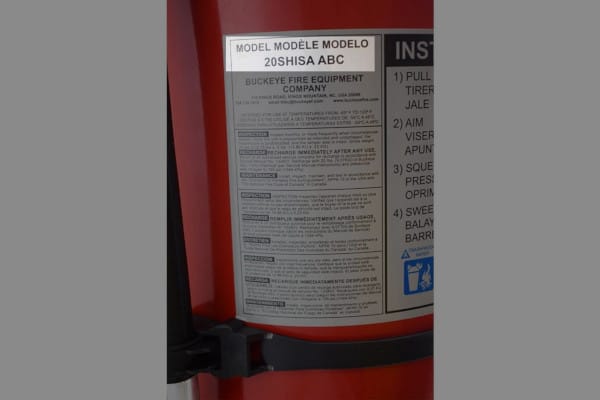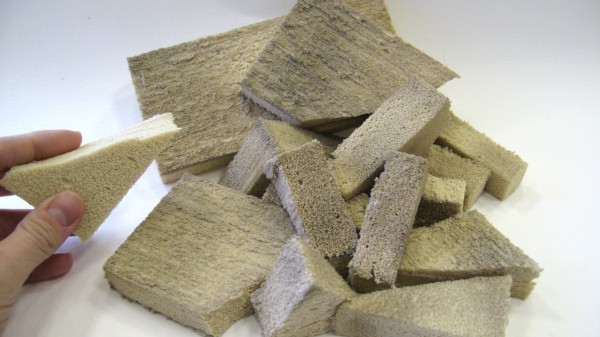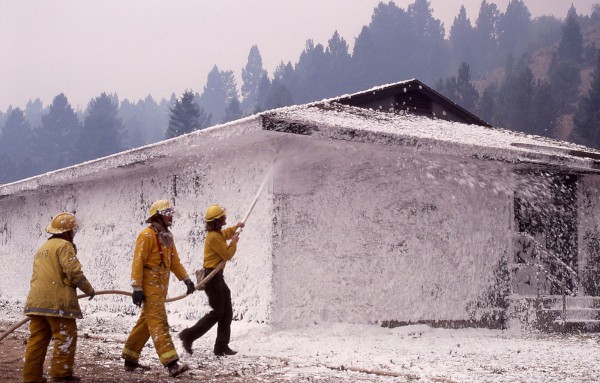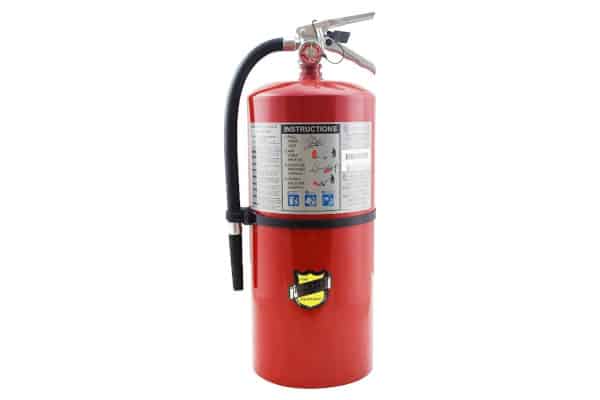The chemicals used can make a big difference in approaches to fire extinguisher clean-up
The red canisters hanging throughout apartment complexes, schools, or workplaces may all look the same—but what’s inside them can vary a great deal. A fire extinguisher’s contents have a big impact not only on what fires it can fight but on how hard it’ll be to clean up the residue when all is said and done. This article looks at the guidelines for fire extinguisher clean-up, including:
- The costs of damage and professional repair
- How to determine what’s inside the extinguisher
- Clean-up for dry chemical, wet chemical, foam, and other common extinguisher types
As we explain later, replacing or refilling those extinguishers soon is a good idea and, often, a legal requirement. Feel free to browse our selection of dry chemical, CO2, and specialty fire extinguishers. To learn more about how to clean up fire extinguisher powder and residue, read on.
Abuse of fire extinguishers can vastly increase otherwise modest clean-up costs
Restoring a fire-damaged building isn’t cheap. While a 1,500 square foot home might need as little as $2,000 for reconstruction and deodorizing after a small fire, fixing more extensive damage can cost tens of thousands of dollars. And while the costs of extinguisher clean-up are hard to quantify—with at least one estimate placing the expense of chemical clean-up at $1,000-$2,500—the price of using an extinguisher is still far less than the price of going without one.
Still, not all uses of extinguishers are benign. It’s a lesson that the Banner School, a private primary and middle school in Frederick, Maryland, learned the hard way. The school closed after vandals discharged as many as seven fire extinguishers in the building. A school administrator placed the costs of clean-up—including new furniture, carpet, computers, and servers—at no less than $140,000.

Photo by Graham Cullen
The Banner School’s experience with fire extinguisher clean-up may be among the worst—but it’s far from the only act of extinguisher vandalism. Here’s a quick look at some incidents:
- A special needs camp in Birch Bay, Washington reported damages exceeding $12,000 after four dormitories were coated in chemical powder. It’s the second such incident in two years.
- A Methodist Church in Ahwatukee, Arizona faced at least a week’s worth of clean-up after attackers discharged two dry chemical extinguishers. Worse, the spray circulated through the building’s ventilation system.
- Two “jockey-boxing” teenagers took what they could from open cars and garages in Kuna, Idaho. On the way, they sprayed vehicles with a stolen fire extinguisher and drove a car off a cliff.
Don’t start fire extinguisher clean-up before figuring out what chemicals you’re working with
As a first step, identify what was inside the extinguisher. This information should be listed on the extinguisher’s label. Here’s a list of common fire extinguishing agents to look for:
- Dry Chemical (Multi-Purpose Dry Chemical, ABC Dry Chemical, Regular Dry Chemical)
- Dry Powder (Graphite Dry Powder, Class D Powder, Copper Powder)
- Foam (ATC Foam)
- Wet Chemical (Wet Agent, Wet Chemical Agent, Liquid Agent, Class K Liquid Agent)
Before cleaning any fire extinguisher powder or residue, it’s important to determine how to do it safely. Each manufacturer makes this data available through a document called an SDS (Safety Data Sheet). Formerly called an MSDS (Material Safety Data Sheet), these documents describe the hazards extinguisher chemicals pose and the procedures to follow when cleaning them.
If a hard copy of the SDS isn’t available, visit the manufacturer’s website (or use your preferred search engine) to locate a digital copy. Searching for the model number, which is often found on the extinguisher’s label, can make finding an exact match easy. OSHA-compliant SDSs offer clean-up guidelines in Section 6, Accidental Release Measures. A list of protective equipment can be found in Section 8, Exposure Controls/Personal Protection.

Reach out to cleaning and fire service professionals sooner rather than later
The next few sections provide guidelines for cleaning up after specific fire extinguisher types. But first, a word of caution: not all extinguisher clean-up is a do-it-yourself task.
Most of these agents pose little threat to walls and floors. But when an agent is poised to enter waterways, plumbing systems, or a building’s ventilation system, it’s probably best left to professionals. Plus, permanent damage can occur if the furniture, carpets, electrical equipment, and other materials aren’t quickly cleaned.
There’s also the matter of getting extinguishers back into service in a timely manner. Local fire codes vary, but, in general, building owners and their representatives must fix problems with extinguishers at a brisk pace. NFPA 10, the leading model fire extinguisher standard, requires problems to be fixed as soon as an inspection uncovers one. Impaired or missing equipment can put occupants at risk. These situations can also become a serious liability for those charged with a building’s upkeep. Replace extinguishers as soon as possible!
Dos and don’ts for clean-up of “dry” (dry chemical or dry powder) extinguishers
Two main types of extinguishers spray a powdery, dry agent:
- Dry chemical extinguishers, a category that contains the multipurpose, ABC-rated extinguishers found in most buildings
- Dry powder extinguishers are used to stop fires in flammable metal

DO:
- Shut down the ventilation system before cleaning.
- Read the MSDS or SDS. Prevent skin and eye irritation with recommended personal protective equipment (PPE).
- Wear a dust mask or respirator if needed. Rated dusk masks can filter particles as small as 0.3 microns—much smaller than the 20-micron particles found in extinguishers. Look for a mask stamped “NIOSH,” “N95,” or “N100,” which is certified to filter 95-100% of these small particles.
- Sweep and shovel the bulk of the contaminant, either using an appropriate dust suppressant or by wet-sweeping.
- Remove residue using a vacuum with a HEPA (High-Efficiency Particulate Air) filter, which collects at least 99.97% of particles 0.3 microns and larger.
- Clean metal surfaces first. Some powders can corrode metal quickly.
- Collect residue in a bag. Dispose of it in accordance with state and local laws.
- Ventilate the area after cleaning.
DON’T:
- Wash the residue into any drain that leads to a waterway.
- Place collected powder back in an extinguisher.
Dry chemical fire extinguisher clean-up advice
Typical composition: Monoammonium Phosphate, Sodium Bicarbonate, Potassium Bicarbonate
Hot tips:
- Break down the silicone in the dry chemical agent with a 1:1 mix of isopropyl alcohol and water. Let the solution sit for a few minutes and rinse with warm water.
- Neutralize bicarbonate powders with a 49:1 solution of hot water and vinegar (1 cup of vinegar to 3 gallons of water), then rinse with warm water.
- Neutralize monoammonium phosphate with a 49:1 solution of baking soda and water (1 cup baking soda to 3 gallons of water). Let it sit for a few minutes and remove with warm water.
- Wash with a mild soap and water solution.
- Clean electrical contacts with an approved electrical contact cleaner.
Additional cleaning advice: A 2013 study from the Colonial Williamsburg Foundation took a look at the difficulty of cleaning ABC dry chemical residue from materials found in museums and historic buildings. Their study found that many materials clean almost entirely (what they termed “exceptional” effectiveness), while others reach a visible clean with minimal residue remaining (“good” effectiveness).

Here’s what the study found about how to clean up dry powder fire extinguisher residue from various surfaces:
- Aluminum (Exceptional): Vacuum and water swab
- Brick (Exceptional): Vacuum and water swab
- Copper (Good): Methods including vacuums, soot erasers, and water swabs
- Iron (Good): Methods including vacuums, water swabs, and detergent
- Leather (Good): Water swabs, vacuums
- Marble (Exceptional): Soot eraser, vacuum, water swab
- Painted Canvas (Exceptional): Vacuum and water swab
- Travertine (Good): Soot eraser
- Tile (Good): Vacuum and water swab
- Wood, Unvarnished (Good): Soot eraser
- Wood, Varnished (Good): Vacuum, soot eraser, and water swab
Dry powder fire extinguisher clean-up advice
Typical composition: Sodium Chloride, Graphite, Copper
Hot tips: These extinguishers fight Class D fires—that is, fires in flammable metal. Some dry powder agents become combustible if airborne. Some clean easily with very little protective equipment, while others require the evacuation of nonessential staff. For safety’s sake, rely heavily on the SDS or MSDS.
Dos and don’ts for cleaning residue from “wet” (wet chemical or foam) extinguishers
The following tips apply to two types of extinguishers:
- Wet chemical extinguishers, used primarily to control “kitchen” fires (those involving cooking grease, fat, or oils)
- Foam extinguishers, which perform well on flammable liquids as well as wood, paper, or other ordinary combustibles

DO:
- Read the MSDS or SDS. Prevent skin and eye irritation with recommended personal protective equipment (PPE), including splash-resistant safety goggles and impermeable gloves. Clothe arms and legs.
- Absorb, bag, and drum the agent for proper disposal.
DON’T:
- Wash the residue into any drain that leads to a waterway.
- Place collected foam or wet agent back in an extinguisher.
Foam fire extinguisher clean-up advice
Typical composition: Varies. Some contain environmentally hazardous perfluorochemicals (PFCs).
Hot tips: Large foam extinguisher spills may need to be cleaned by a professional. Even limited exposure to some foam agents can cause damage to the nervous system or vital organs.
General guidelines:
- Don’t spray the foam with water, which will generate more foam. Vacuum, pump, or use absorbent materials on the residue instead. Then, remove the residue with detergent and water.
- For foam agents with known adverse health effects: Wear an air-purifying respirator for prolonged cleaning. Use positive-pressure air respirators—those designed to prevent the entry of contaminants using added air pressure within the hood or helmet—around high concentrations of airborne agents. Ventilate the area well. Professional clean-up is recommended!
Wet chemical fire extinguisher clean-up advice
Typical composition: Potassium Acetate, Potassium Carbonate, Potassium Citrate
Hot tips: Residue from these kitchen fire extinguishers typically cleans up with hot water and soap. Shut off power to cooking equipment before cleaning. Discard any food that has come into contact with the agent.

Replace exhausted extinguishers quickly from the selection at QRFS
Restoring a building after a fire or an act of vandalism can be an overwhelming task. But with an understanding of an extinguisher’s contents—and some how-to tips—most fire extinguisher powder or liquid residue can be quickly and safely cleaned.
If you need new fire extinguishers to bring your building back into compliance with fire code, take a look at QRFS’s stock of extinguishers from Buckeye, a North Carolina-based manufacturer with a selection of UL-listed extinguishers for a wide range of hazards.
If you’re not sure what extinguisher you need, take a look at the following resources:
- “When and Where Should Fire Extinguishers Be Installed? A Practical Guide for Building Owners“
- “Ultimate Guide to Fire Extinguisher Classes: Servicing and Use“
- “What Does the Number on a Fire Extinguisher Mean?“
Browse our selection of fire extinguishers.
Still need help? Call us at +1 (888) 361-6662 or email support@qrfs.com.
This blog was originally posted at blog.qrfs.com. If this article told you what you needed to know about fire extinguisher clean-up, check us out at Facebook.com/QuickResponseFireSupply or on Twitter @QuickResponseFS.



I liked how you mentioned that you should ventilate an area after using a fire extinguisher. My wife and I are wanting to get a home with a fireplace and we were wondering what we should do if there’s an accident we need to use an extinguisher in our living room. I’ll be sure to tell her that we should ventilate the living room if we need to use a fire extinguisher.
Hi
I will like to purchase your product.
Do you allow pick up via Courier Company or freight forwarders?
What types of credit cards do you accept?
Awaiting your response
Regards,
Nicholas Henry
CEO
QUANTUM & SON’S INT
1289 MH MAJURO
MARSHALL ISLANDS
ceooffce138@gmail.com
Nicholas, thank you for reaching out. We will have someone from our QRFS Customer Support Team contact you.
Want to Know What agent is in a Firexo7 Fire extinguisher that’s used for Lithium Battery Fires
Angel — We don’t sell these extinguishers and aren’t familiar with their contents; your best bet would be contacting Firexo. Thanks for reading!